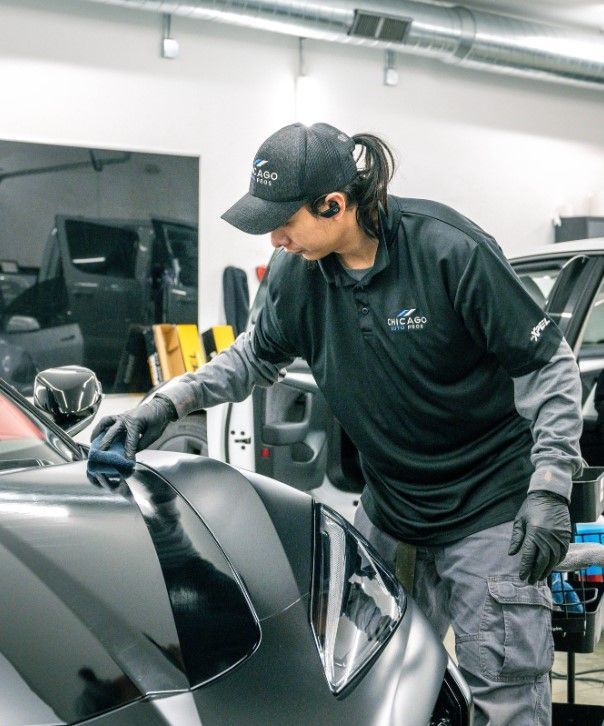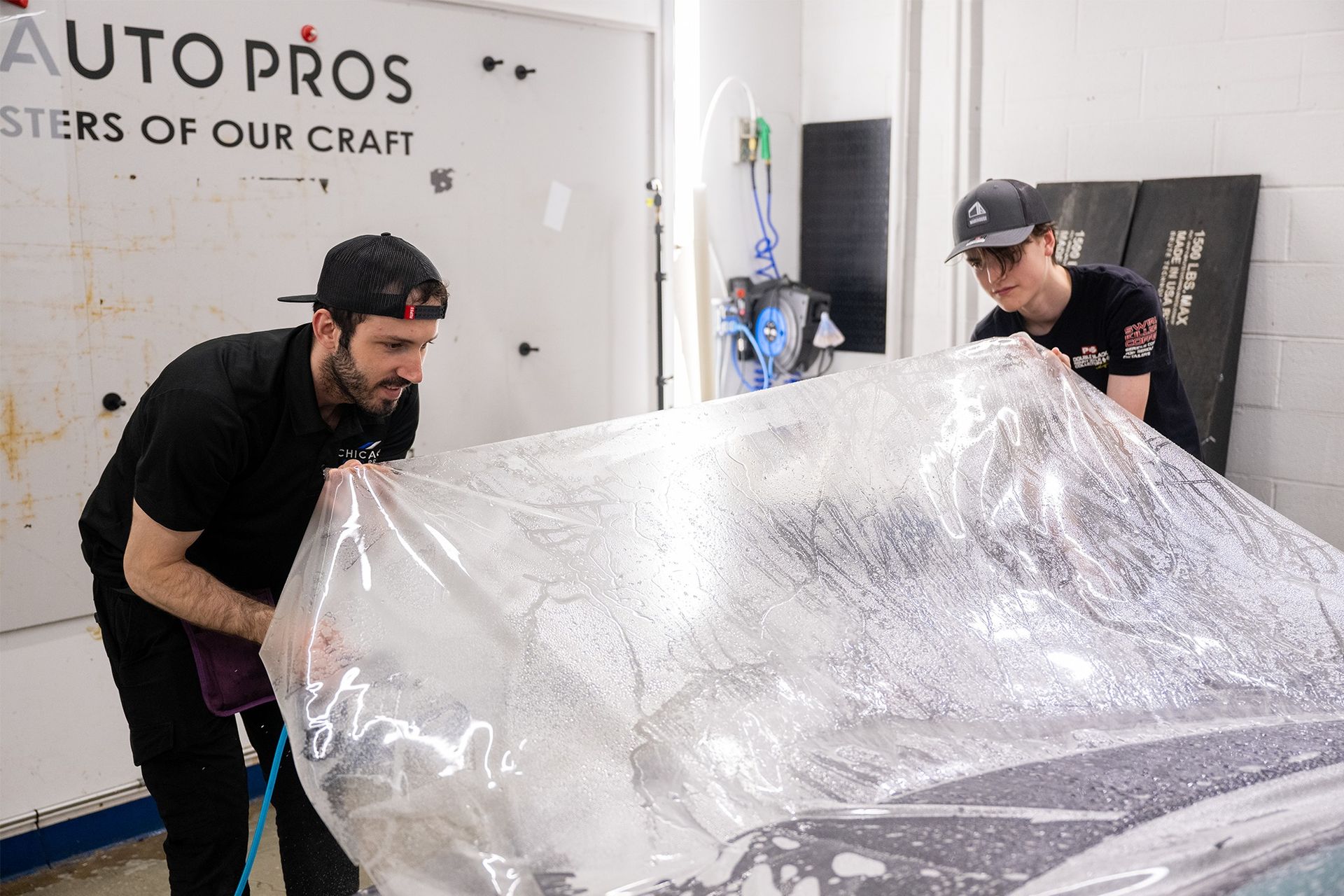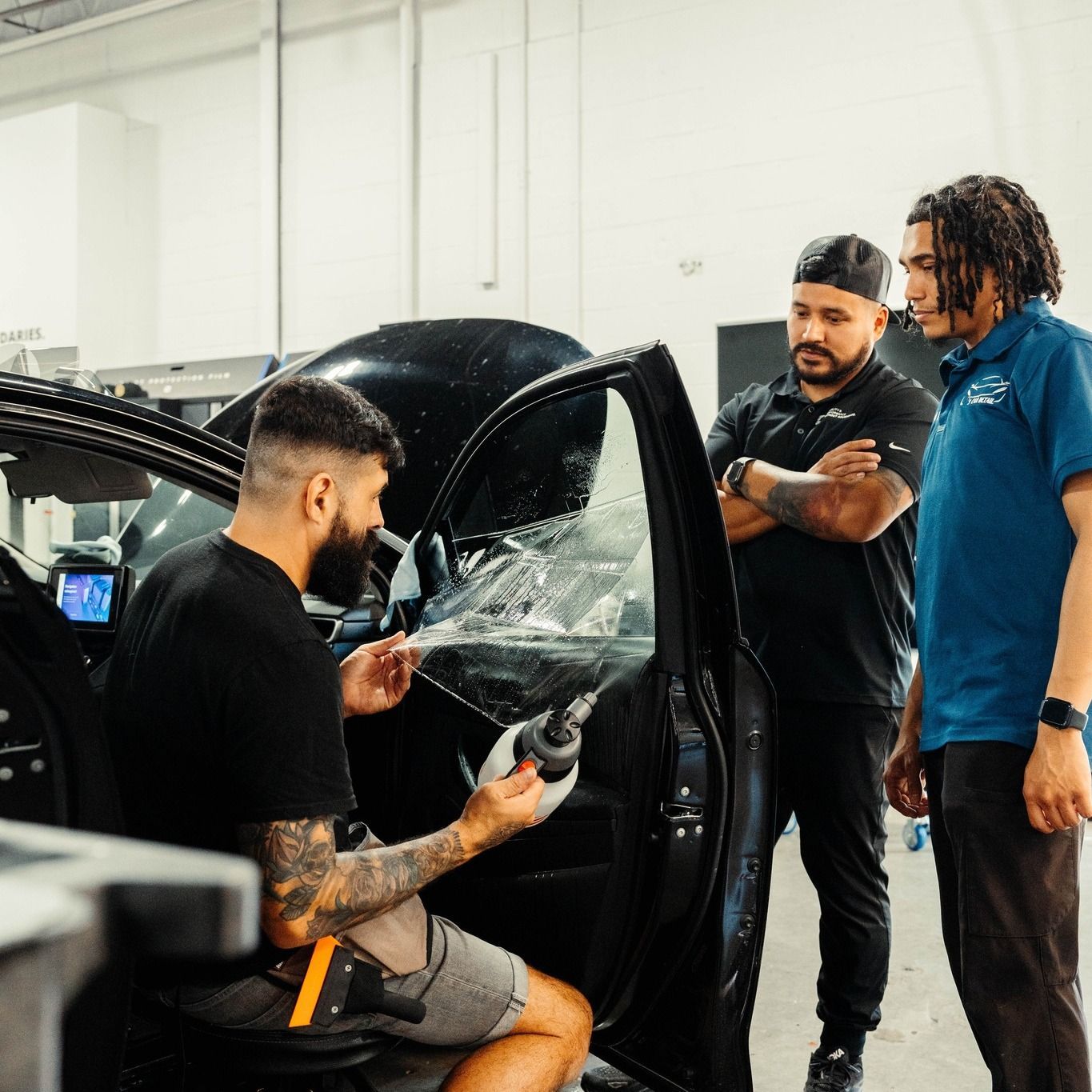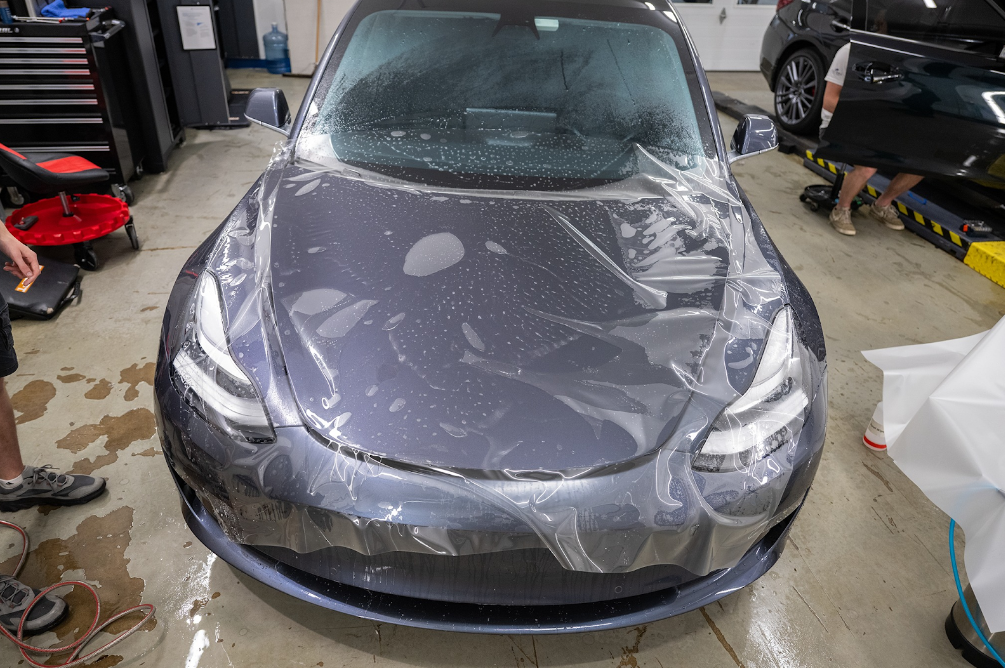Choosing between ceramic coatings and wax for car protection can seem like a minefield of competing options with no one-size-fits-all solution. On the one hand, ceramic coatings can provide an even and durable layer of protection, while wax offers a fast application but may not last as long.
So which is the better car protection option for your vehicle? Your local auto detailing shop might have some recommendations.
In this blog, we're going to dive deeper into the differences between these two car protection options, exploring the pros and cons of each so you can make an informed decision next time you're looking for a car protection product at an auto detailing shop.
Let's get started!
What Is Ceramic Coating?
When it comes to protecting the exterior of a car, ceramic coating is quickly becoming one of the preferred options. Primarily due to their durability and long-lasting protection, ceramic coatings, like the popular Gtechniq coatings, are starting to become a go-to product for car enthusiasts. But what is a ceramic coating?
Ceramic coating is a liquid polymer that bonds with paint and forms a protective barrier on your vehicle's surface. It creates an ultra-smooth layer that resists abrasion and environmental contaminants like tree sap, bird droppings, and UV rays. Ceramic coating also amplifies your vehicle's shine and helps repel dust, dirt, and other unwanted particles from sticking to your paintwork.
It's not as cheap as waxing but should last much longer than wax—some report up to 5 years' worth of protection from a single application!
Are there any disadvantages to applying ceramic coatings? Some people claim that they do not offer the desired level of protection, particularly when it comes to larger items such as rocks or branches coming into contact with the car's bodywork.
Also, because it's quite expensive, some feel that traditional waxes are just as effective at providing decent protection while costing significantly less.
On the other hand, some people say that these products are much better than traditional waxes because of how strong the polymers are, how well they stick, and how much shine they add. With these contrasting opinions about ceramic coatings and their benefits for protecting cars, it begs the question: how does it differ from traditional waxes?
To answer this crucial question and understand it further, we need to take an in-depth look into the specifics of both products.
How Does It Differ from Traditional Wax?
When comparing ceramic coatings to traditional waxes, there are notable differences between the two car protection options. Traditional waxing is the process of applying a wax formula to the car's paint to provide a protective shine.
Waxing should be done at least twice a year for adequate paint protection. If left for too long, the protection decreases and wears off completely. While waxing does offer basic protection from UV rays and minor wear, it is relatively short-term and requires frequent reapplication to maintain effectiveness.
Ceramic coatings, on the other hand, offer significantly greater protection against road grime, UV rays, dirt, and other contaminants. It is applied as a liquid polymer that bonds with the car's paint, forming a long-lasting barrier of protection that surpasses even carnauba wax in durability. They add an additional layer of gloss that can last up to 4 years before needing reapplication
Although more expensive than traditional wax products, the durability of ceramic coatings makes them a superior option for those seeking better car protection, even in varying weather conditions.
It's clear that when compared side by side, ceramic coating surpasses traditional waxes, like carnauba wax, in terms of day-to-day wear and tear protection and long-term UV resistance. However, traditional waxes still offer basic protection while being budget-friendly.
Ultimately, the choice depends on the desired level of protection and the willingness to invest. If optimal vehicle care and protection are priorities, ceramic coating is worth considering as the preferred option.
Next, we'll explore the exclusive benefits offered by ceramic coatings that make them the preferred choice over their counterparts.
Benefits of Ceramic Coating Over Waxing
When considering the difference between ceramic coating and waxing your car, the potential benefits of this modern protection option are considerable. The most obvious advantage of ceramic coating over waxing is durability. Quality coatings can last upwards of 5 years, while wax typically needs to be applied every several months to keep it looking fresh. This means that ceramic coating is an excellent option for those who want superior protection without having to frequently pay for services or do it themselves.
Additionally, some people find that wax, especially carnauba wax, requires a lot of upkeep and thus prefer the more "set-it-and-forget-it" feeling of ceramic coatings. Ceramic coating also provides a glossy finish that is often seen as superior to the look of waxed cars. In addition, the procedure, when compared to conventional waxing methods, can result in increased hydrophobicity, making it easier and quicker for water droplets to bead off a vehicle, cutting down on the time needed for maintenance or cleanup.
Taking care of a ceramic-coated car is also easier than maintaining one with wax, as dirt and grime don't stick to the coating like they do with wax.
Overall, it's clear that there are numerous benefits associated with opting for ceramic coating instead of traditional waxes like carnauba wax. While there are debates about which protective method has superior long-term effects and cost-effectiveness, the clear advantages in terms of cleanliness and durability make ceramic coating an attractive option for many car owners.
Plus, with features like enhanced hydrophobicity, you can rest assured knowing that your vehicle's finish will remain slick and shiny no matter what weather conditions you put it through. Next, we'll explore more deeply how these coatings can provide long-lasting protection against common wear and tear as well as how they can help keep your car safe from any potential security risks.
You Might Also Like to Read: Maximizing the Benefits of Ceramic Coatings for Your Investment
Long-Lasting Protection and Security
When it comes to long-lasting protection and security for your car's exterior, it is difficult to argue against ceramic coatings. They offer an additional layer of defense against scratches and abrasions on various surfaces, in addition to protecting against environmental exposure-related fading.
On the other hand, waxing offers a more short-term solution, as it can quickly wear off when exposed to elements like heat and rain.
Ceramic coatings often include hydrophobic properties that repel rainwater and keep road grime at bay, reducing the frequency of visits to the car wash. The inherent ability of ceramic coatings to resist corrosion makes them far superior to waxing alone. According to an independent study by the University of California, ceramic coats showed no signs of oxidation over a five-year period, while cars with waxed exteriors showed noticeable changes in paint color within two years, particularly on surfaces exposed to constant heat.
At the end of the day, ceramic coatings provide much better protection against dirt buildup, fading from UV exposure, and oxidation caused by corrosive materials. After considering the long-term benefits offered by ceramic coatings, especially when compared to waxing, the decision should be simple.
However, it's important to note that there are specific terms and steps you must follow to ensure the prolonged effectiveness of the coating.
Maintenance Involved with Ceramic Coatings
It's important to keep in mind that ceramic coatings typically require less care and attention than wax when it comes to maintenance. Ceramic coatings can protect a car for up to 1–5 years, while wax needs more frequent reapplication due to its shorter lifespan on various surfaces. To maintain the car's shine with a ceramic coating, periodic cleaning and polishing are still beneficial.
Car owners will still need a wash mitt and detailing spray, but they will no longer need to apply wax. Even in extreme heat, the coating provides an invisible layer of protection while preserving the car's exterior beauty. While some may argue that ceramic coatings necessitate a longer commitment, this is not always the case.
It's true that certain types of ceramic coatings may be prone to chipping or peeling over time, requiring reapplication every few years for maintenance. However, there are options available that offer better-than-average results in terms of long-term durability, especially when correctly applied.
Ultimately, the longevity and maintenance requirements of a ceramic coating will depend on the type chosen and how well it is applied. As a result, many drivers believe that ceramic coatings are more cost-effective overall than applying wax on a regular basis over the same time period.
Regardless of the chosen option for car protection, both ceramic coatings and wax have their own unique maintenance demands. Before deciding what is best for your vehicle's needs, it is recommended that you learn how to properly apply and maintain the chosen product to ensure optimal results.
After examining each type of protection's surface security and lasting power, let's look at the application process to see which is easier or faster.
- Ceramic coatings can provide a layer of protection up to 10 times thicker than traditional wax.
- A study published in 2019 found that ceramic coatings increased a vehicle's hydrophobic properties by 40% when tested against traditional waxes.
- According to a case study by Elite Coatings Australia, ceramic coatings can withstand temperatures of up to 1200°C and provide protection from UV rays, acid rain, and bird droppings, while traditional waxes typically offer no protection from these elements.
How Easy is the Application Process?
When deciding between ceramic coating and waxing in the context of modern technology, the ease of application becomes an important factor to consider, especially when considering the environment and the value of your time.
Ceramic coatings require more expertise and experience to apply to a vehicle's exterior. The product must be applied with extra care, making sure all residue is removed and confirming that the entire surface is covered.
Waxing, on the other hand, does not require such precision and is doable even by inexperienced car owners. However, achieving a good result with wax and buffing takes more time and energy than applying a ceramic coating, which can be done in a single, quick application.
Despite the need for more technique in ceramic coating application, advanced technology during the process provides several benefits.
A single application of ceramic coating can last at least 2 years without requiring any maintenance, saving the car owner valuable time compared to wax, which needs regular reapplication every three months or so.
Additionally, applying wax with proper buffing can take up to 8 hours, whereas a ceramic coating only takes 1-2 hours, allowing you to enjoy your car much faster and minimizing the impact on the environment.
Finally, consider whether you have the necessary skill and patience for a successful ceramic coating application or whether you prefer less work with potentially fewer results, which wax offers.
Following that, we'll go into more detail about the various ceramic options you have, which might help you make a decision.
The Differences Between Different Ceramics
When it comes to ceramic coatings, there are various levels of protection available, ranging from basic scratch resistance to high-grade abrasive protection. These two major categories are chemical ceramics and organic ceramics. Chemical ceramic coatings utilize advanced polymer resins while organic ceramic coatings form chemical bonds, creating a stronger and more durable protective barrier.
Therefore, organic ceramics are generally the preferred choice for long-term protection.
The type of ceramic coating you choose for your vehicle depends on the level of protection you require and your budget. Chemical ceramic coatings are typically less expensive but have a shorter lifespan. On the other hand, organic ceramics are more costly but can last up to 5 years with proper maintenance, offering long-term value.
Higher-end ceramic coatings also possess self-cleaning properties, which help keep your vehicle looking clean for extended periods, reducing the need for regular waxing and minimizing tedious car maintenance. Furthermore, premium ceramic coatings exhibit hydrophobic and oleophobic characteristics, repelling water and oil, respectively. This feature protects against dirt and dust buildup and makes cleaning easier, ultimately reducing your car's environmental impact.
When deciding between chemical or organic ceramics, consider the desired extended lifespan of the coating and your budget while also considering the value of advanced technology and its environmental implications.
With the right information, you can make an educated choice that provides maximum protection for your car, regardless of the type of ceramic coating you select.
Now that we have discussed the differences between various ceramic types, let's take a closer look at how these coatings compare to traditional waxes in terms of protecting our vehicles from the elements and everyday wear and tear.
Comparisons Between Ceramic and Traditional Wax
When comparing traditional wax and ceramic coatings, both options have their advantages and disadvantages. Traditional wax provides a glossy layer of protection that can last for up to 3 months, depending on the car's usage. In contrast, ceramic coatings offer long-term protection that can endure for up to 2 years. Waxing is relatively easy to apply and requires minimal effort, while ceramic coatings are more labor-intensive, involving multiple steps and careful application.
In terms of protection, traditional waxes offer some defense against minor scratches, dirt, and UV exposure. However, they are less effective against substances like bird droppings and acid rain. Additionally, wax may lose its effectiveness over time, particularly if the car is driven frequently or exposed to extreme temperatures.
On the other hand, ceramic coatings provide superior protection by forming a hard barrier that resists environmental damage and chemical buildup more effectively than wax. They also prevent pollutants from permanently etching into the paint surface. Moreover, ceramic coatings enhance glossiness and clarity, resulting in a more visually appealing finish. When considering cost efficiency, traditional wax is usually cheaper than most ceramic coatings. Waxes are affordable and readily available, while ceramic coatings tend to be more expensive and have a more limited selection on the market.
However, if you take into account the long-term benefits and enhanced protection provided by ceramic coatings, it may be worthwhile to invest in them for superior vehicle protection over time. Ultimately, the choice between traditional wax and a professional-grade ceramic coating depends on personal preference. It's important to weigh the benefits, costs, and long-term goals for your vehicle's protection when making a decision.
Unleash Unmatched Gloss and Durability with Chicago Auto Pros Ceramic Coating Installation in Glenview, Illinois
Experience the peak of car protection and aesthetics with our professional ceramic coating installation at Chicago Auto Pros. Our expert professional detailers utilize advanced techniques and state-of-the-art products to deliver unmatched gloss and durability for your vehicle.
Don't settle for the ordinary when you can have the extraordinary. Trust us for exceptional craftsmanship and unleash the full potential of your vehicle's appearance. Give us a call today for more information and to book your appointment!
We Make Your Car Look Beautiful
Founded with an unquenchable desire for automotive perfection, Chicago Auto Pros is a leader in paint protection efforts and aesthetic vehicle detailing services in Chicago, Illinois. When you bring your automobile to our Chicago-based detailing shop, you are sure to experience unmatched integrity, customer service excellence, and above all, absolute automotive perfection from the inside out. Choose the right auto detailing team - choose Chicago Auto Pros!
Lombard Location
207a Eisenhower Ln S, Lombard, IL, United States
Glenview Location
2075 Johns Ct, Glenview, IL, 60025, United States
Additional Service Areas
Tesla & EV Detail Specialists
Services Offered
Quick Links
All Rights Reserved | Chicago Auto Pros






